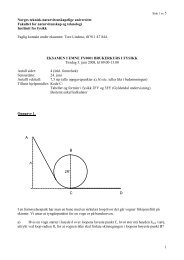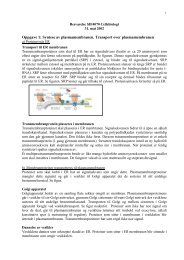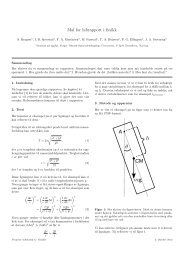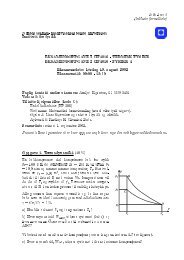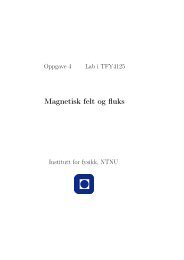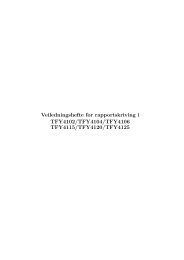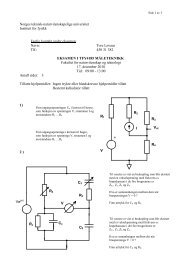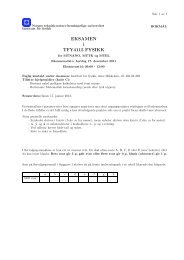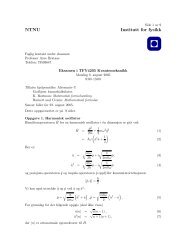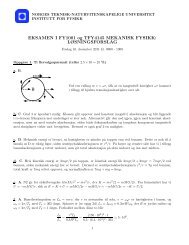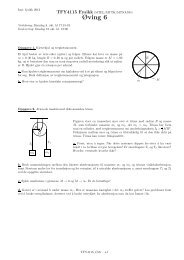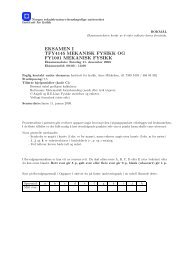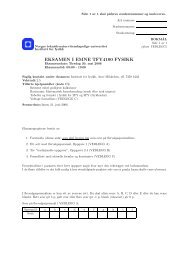DEPARTMENT OF PHYSICS, NTNU - intern - NTNU
DEPARTMENT OF PHYSICS, NTNU - intern - NTNU
DEPARTMENT OF PHYSICS, NTNU - intern - NTNU
Create successful ePaper yourself
Turn your PDF publications into a flip-book with our unique Google optimized e-Paper software.
RESEARCH<br />
DIVISION <strong>OF</strong> APPLIED <strong>PHYSICS</strong> AND DIDACTIC <strong>PHYSICS</strong><br />
Staff<br />
Ass. Professor Per Morten Kind<br />
Professor Berit Kjeldstad<br />
Professor Ole J. Løkberg<br />
Ass. Professor Jørgen Løvseth<br />
Ass. Professor Tore Løvaas<br />
Professor Hans M. Pedersen<br />
Professor Helge R. Skullerud<br />
Ass. Professor Thorarinn Stefansson<br />
Ass. Professor Kaare Stegavik (retired 2002)<br />
Ass. Professor Knut Arne Strand<br />
Professor emeritus Johannes Falnes<br />
Professor emeritus II Reidar Nydal<br />
Professor emeritus R. Svein Sigmond<br />
Overview<br />
The research is mainly carried out within fields of<br />
electron and ion physics, energy and environmental<br />
physics, optics in addition to physics didactic. These<br />
contain several sub-fields with a large variety of topics.<br />
A brief overview is given. For the year 2002 we have<br />
chosen to give a more extended description of two<br />
research topics: Detecting hydrocarbon reservoirs in<br />
deepwater areas by Hans M. Pedersen, and Exploring<br />
technology in Norwegian education by Per Morten<br />
Kind.<br />
Survey of research activities<br />
The research is focused on several different topics as<br />
electrical breakdown in fluids and gases (Løvaas,<br />
Sigmond); transport of ionized gases (Skullerud).<br />
Research on video holography, and fibre optics<br />
interferometry are being performed (Løkberg).<br />
Classical coherence theory with applications to the<br />
statistical foundation of radiometry is studied, as well<br />
as linear system theory models for signal processing<br />
and speckle statistics in optical coherence tomography<br />
(Pedersen). Thermal fluctuations in mixtures of<br />
alkanes and in natural gas in gas phase and in<br />
condensed phase, as well as on the interface, are<br />
studied by laser light scattering. Measurements are<br />
performed at reservoir conditons (Strand). Renewable<br />
energy sources as wind, solar radiation (Løvseth) and<br />
ocean waves are studied (Falnes). Ultraviolet<br />
climatology is studied with emphasis on processes<br />
affecting transmission of ultraviolet radiation to the<br />
surface, for instance importance of aerosols and clouds<br />
(Kjeldstad). Finally there is research related to<br />
educational physics with particular emphasis on the<br />
interaction between practical work and the students’<br />
perception on the nature of science (Kind).<br />
Development of a learning model adjusted for the<br />
10<br />
situation how to learn through laboratory work.<br />
Educational materials are developed for testing the<br />
model (Stefansson).<br />
Examples of Research carried out in 2002<br />
1. Electromagnetic seabed logging (SBL)<br />
By Hans M. Pedersen<br />
SBL is an application of marine, controlled source<br />
electromagnetic sounding that can improve the<br />
accuracy in detecting and characterizing hydrocarbon<br />
reservoirs in deepwater areas. The basis of SBL is the<br />
use of a mobile horizontal electric dipole radiation<br />
source and an array of seafloor electric field receivers.<br />
The dipole source transmits a low frequency<br />
electromagnetic signal (0.05 to 10 Hz) into the<br />
overlying water column and downwards into the<br />
underlying sediments. Electromagnetic energy is<br />
rapidly attenuated in the conductive sea water and<br />
seafloor sediments, but in a high-resistive layer, e.g., in<br />
a hydrocarbon filled reservoir, electromagnetic energy<br />
is attenuated less and propagation is more efficient<br />
along the layer. Energy constantly leaks from the layer<br />
back to the seafloor, and when the source receiver<br />
offset is comparable to or greater than the depth of<br />
burial the energy from the layer will dominate over the<br />
directly transmitted energy. The detection of this<br />
guided energy is the basis of SBL.<br />
The method was developed at the Statoil R&D Center<br />
in Trondheim and is now commercialized and further<br />
developed by the company EMGS AS<br />
(ElectroMagnetic GeoServices), Trondheim,<br />
(www.emgs.no). The <strong>NTNU</strong> activity in the SBL<br />
development started with theoretical models and field<br />
measurements in a down-scaled experiment at<br />
Figure: Illustration of SBL survey-layout: energy from<br />
a towed electric dipole source is guided through deeply<br />
buried high-restive layers and detected by an array of<br />
seafloor antennas.



